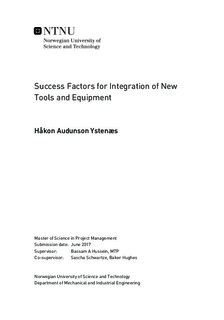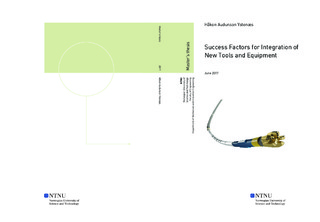| dc.description.abstract | The oilfield service industry is currently exposed to strong competition. In order to remain competitive, oilfield service companies are dependent on streamlined operations, which can be achieved by e.g. developing and applying new and more efficient products and technologies. Baker Hughes, a United States oilfield service company among the largest in the world, is now at the final stage of developing a new drilling system called the One-Trip System (OTS), which is to be tested operationally in the summer of 2017. The Norwegian department of the company is the first in Baker Hughes' organization to incorporate the new system. Based on experience, the implementation of new products is a challenging process within the company and the industry. Increasing the likelihood of successful integration of the new system into the organization is thus desirable.
There is a great deal of literature that examines the importance and application of critical success factors in projects. Studies show that there are some specific factors that, if followed by the project and its stakeholders, may increase the likelihood of a successful project. Some studies focus on success factors for projects in general, while others look at specific project types, such as product development, IT and implementation projects.
This study aims to determine the critical success factors for the integration of new tools and equipment in oilfield service companies, which may aid the integration of the OTS within the Norwegian department of Baker Hughes.
The critical success factors are mapped using a mixed method where findings from case-projects are compared with findings from relevant literature. All the presented case-projects have similar features as the OTS project, as they all relate to the integration and implementation of new products.
Based on the findings from the case-projects, a set of critical success factors for the integration of new tools and equipment in the oil service industry is proposed and presented. These success factors are analyzed and compared with findings from the literature study. It appears that the findings from the case-projects are supported by literature on success factors within projects, project implementation and change management, which increases the validity and generality of the research. The final list of critical success factors is presented below.
- Capable and experienced project manager
- Dedicated and committed project manager
- KPIs must support and reward use of new technology
- Upper management support and trust
- Early and continuous involvement of end-user
- Openness
- Communication
- Training of end-user | |

